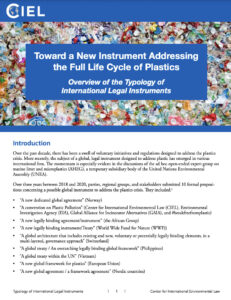Source >>>

Over the last decade, there has been a swell of voluntary initiatives and regulations designed to address the plastics crisis. More recently, the subject of an intergovernmental, legal instrument designed to address pollution from plastic has emerged in various international fora. Between 2017 and 2020, parties, regional groups, and stakeholders submitted 10 formal propositions concerning a possible global instrument to address the plastics crisis. These propositions used various terms to refer to the instrument, including agreement, convention, treaty, framework, and others.
Negotiations for this global instrument are scheduled to begin during the upcoming fifth session of the United Nations Environmental Assembly (UNEA5.2) in February 2022. Ahead of this, it is critical to understand the types of international legal instruments that states can pursue. Comprehensive discussions surrounding a potential new international instrument must include preliminary deliberations that address these questions: What type of instrument is envisaged (e.g., an agreement, treaty, convention)? And what is the potential structure of the instrument (e.g., framework, protocols, annexes/appendices)?
“Toward a New Instrument Addressing the Full Life Cycle of Plastics: Overview of the Typology of International Legal Instruments” is a legal overview that provides a non-exhaustive analysis of various international legal instruments, focusing on Multilateral Environmental Agreements (MEAs). It considers the practical distinctions, including title and the inception of the negotiation process, and provides a background on the preparation and negotiation of international instruments. Furthermore, it highlights treaty-making tools to consider during current discussions and future negotiations. In doing so, it aims to inform decision-making in the context of the development and adoption of a new global instrument governing the life cycle of plastics.
Published on January 20, 2022SHARE:

